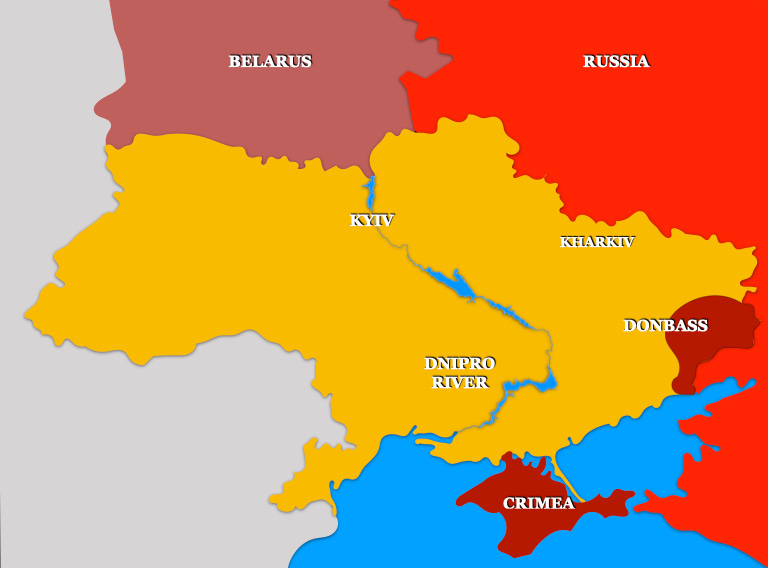During the last week of February of 2022, Russian forces moved rapidly through the part of Ukraine that connects the Crimean Peninsula to the Dnipro River. In a maneuver that resembled the many “rapid occupation” campaigns conducted by Soviet forces in 1939 and 1940, they quickly took control of an area of some twenty-thousand square miles and a population of some two million souls.
In the same period, other Russian forces traveled through an area of larger size and greater population located along the frontiers that separate Ukraine from Russia and Belarus. However, where their comrades in southern Ukraine took possession of all cities in their path, the Russian forces in the northern part of that country bypassed all of the urban areas they encountered. Similarly, while a legion of civil servants, bankers, and media mavens from the Russian Federation followed in the wake of the Russian formations in the south, no such movement took place in the north.
In the month of March, while Russian administrators wrought many changes upon the recently conquered regions in the south, Russian forces in the north persisted in their policy of avoiding sustained contact with the urban population. Stranger still, during the first few days of April, all of the Russian formations that had been operating in northern Ukraine withdrew from that country.
The rapid departure of Russian forces from northern Ukraine raises the question of what they were doing there in the first place. The explanation most often offered in the English-speaking world is that of the “bungled blitz.” That is, the Russians tried to do in the north what they accomplished in the south but, thanks to a combination of their own incompetence and Ukrainian resistance, they were not able to manage it.
An alternative interpretation puts Russian operations in the north of Ukraine into the category of “raids.” That is, like the great cavalry operations of the American Civil War and the exploits of the column led by Alexander Chernichev during the Leipzig campaign of 1813, the Russian incursion into northern Ukraine was an act of military misdirection. To be more precise, it was a large-scale demonstration aimed at convincing the Ukrainian leadership “to weaken their main field army, then fighting in the Donbass region, to bolster the defenses of distant cities.”1
Proponents of a third theory argue that the Russian columns drove towards such places as Kyiv and Kharkiv in order to link up with “fifth columns” that had already taken control of those cities. While this narrative seemed farfetched, it accords with a curious incident that happened in the city of Kharkiv on the fourth day of the Russian invasion.
On 27 February 2022, eight unarmored vehicles, each emblazoned with the letter “Z”, drove down one of the broad avenues that connects the beltway surrounding Kharkiv with the center of the city. Ambushed by a group of armed volunteers, the men riding in these trucks took refuge in a school where, after a brief firefight, all were either killed or captured.2
Of course, if we apply William of Ockham’s famous razor to this event, it seems much more likely that the leader of the convoy had, in the course of an errand that put him on a highway north of Kharkiv, merely taken a wrong turn.
Marinus (pseudonym), “The Russian Invasion of Ukraine: The Mental and Moral Realms” The Marine Corps Gazette, August 2022, pages 90-94. (This article, alas, was published on the far side of a paywall.)
Videos depicting the ambush of the Russian convoy can be found on the Telegram channel of Kostyantyn Nemichev, who would later organize the Kraken Special Unit.







Not sure how you fit the failed Russian paratrooper assault on the airport in Kyiv, the stranded column heading towards the capital, the high casualty rate and loss of equipment in which dress uniforms were found. Unless you have solid grounds to say that this was all fake news, then the easiest solution is to believe Putin when he first expressed his war aims for Ukraine, namely to decapitate its government (controlled by some combination of Nazis and drug addicts) and reincorporate it into Russia.
If this maneuver was meant to be a raid to draw off Ukrainian soldiers from fighting in the East, it was a very costly sideshow and doesn’t adequately explain the Ukrainian counter-offensive that dislodged Russian forces from parts of the Donbas. It also fails to account for the on-the-scene reporting by Russian military bloggers expressing anger at their military’s performance - unless they too are part of a disinformation campaign which we would have to believe is principally targeted at the Russian home front (unless they are all in on it as well - in which case we have entered a tin-hat conspiracy zone).
From a distance, and given both sides’ interest in pushing their own narratives and propaganda, it is hard to make clear sense of what is actually happening on the ground. Let’s just say that I’m skeptical of your take.